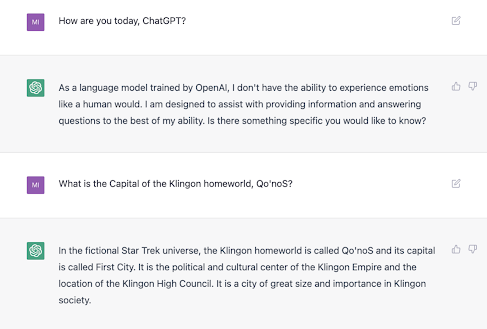The 3 Most Common Uses of ChatGPT
Introduction
Artificial intelligence is capturing the eye of many people in today's technological world. Many AI (artificial intelligence) tools are being developed and released freely to the public. OpenAI, one of the leading artificial intelligence research companies, has an AI tool named DALL-E. DALL-E has the ability to generate images based on text prompts.
If one were to input, "An astronaut riding a horse in photorealistic style," a surprisingly accurate output would be generated.
 |
| An example taken from OpenAI's web page about DALL-E |
This tool exhibits great potential and could be utilized in many different ways both personally and professionally.
What is ChatGPT?
Similar to DALL-E, ChatGPT, which is perhaps today's most popular AI tool, is a language model developed by OpenAI. It is capable of processing natural language to generate responses to many different kinds of question prompts.
 |
| A view of ChatGPT's user interface |
All kinds of questions can be asked and ChatGPT will search its immense text database to formulate a response. Additionally, the response from ChatGPT can be followed up and the question-and-answer dialogue becomes more like a conversation.
How can it be used?
With the numerous capabilities this language model presents, the three most common uses of ChatGPT are as follows.
1. Answers to Questions
The simplest of uses of ChatGPT is to ask a question to receive an answer. Similar to tools like Siri, Google, and Alexa, ChatGPT will answer all kinds of questions. Questions that begin with "who, what, when, where, why, and how," are the basic starters for any question for ChatGPT.
Its responses are generated to the best of its ability. If it does not have enough information, is unable to respond accurately, or simply does not understand, ChatGPT will notify its user.
While this tool can be very helpful in order to generate information fast, it does not need to be an end-all-be-all. The tool may generate incorrect and inaccurate information and informs users of this shortcoming. It is always best to follow up with one's own personal research and use ChatGPT as a starting place.
2. Content Creation
ChatGPT is also used often for content creation. By using ChatGPT to create fresh ideas for articles and blog posts, writers and bloggers may save time and effort while still producing interesting material for their viewers.
Writers may concentrate on the creative process rather than the specifics of writing by using ChatGPT to help them create headlines, outlines, and even full paragraphs. ChatGPT may also assist content producers in producing content for blog posts, email newsletters, and other marketing materials.
 |
| Courtesy of Blue Flame Thinking |
3. Entertainment
In addition to it's more practical uses, ChatGPT is also used for entertainment. For instance, some individuals like using ChatGPT to create jokes, stories, and even poetry. Users may converse with artificial intelligence-generated personas using ChatGPT's virtual chat companion feature.
In addition, ChatGPT may be used to develop interactive games and puzzles. Seeing even more inventive and imaginative ChatGPT applications in the entertainment industry in the future is not a shocking reality.
 |
| A ChatGPT generated and themed word jumble |
Conclusion
These are only a handful of ChatGPT's numerous applications. We may anticipate seeing even more cutting-edge uses for ChatGPT and other comparable language models as AI technology progresses.
ChatGPT is a useful tool that may assist in achieving your objectives more successfully and efficiently, whether you're someone who is looking for answers to questions, a content producer searching for fresh ideas, or someone who is looking for entertainment.

Comments
Post a Comment